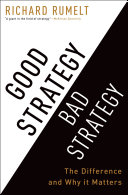

A good strategy begins with a clear vision of what the organization aims to achieve. This vision acts as a guiding star, helping to align efforts and resources towards common goals. Without a clear vision, organizations can easily drift into confusion and misalignment, leading to wasted resources and missed opportunities. A well-defined vision allows for the identification of critical issues that need addressing, creating a roadmap for success. It also inspires and motivates employees, ensuring that everyone is on the same page and working towards the same objectives.
Continue readingBad strategy often masquerades as good strategy. It is characterized by vague goals, a lack of focus, and an absence of actionable steps. Good strategy, on the other hand, is specific, actionable, and addresses critical challenges. It involves a deep understanding of the competitive landscape and a clear articulation of how to navigate it. Recognizing the difference between these two types of strategy is crucial for leaders, as it helps them avoid common pitfalls and focus on what truly matters for their organization's success.
Continue readingA critical component of good strategy is a thorough diagnosis of the situation at hand. This involves analyzing the internal and external environments to identify key challenges and opportunities. A well-conducted diagnosis allows leaders to understand the root causes of problems rather than just treating symptoms. This understanding is essential for formulating effective strategies that address real issues. Without a proper diagnosis, organizations risk implementing solutions that do not tackle the underlying problems, leading to further complications down the line.
Continue readingGood strategy emphasizes the importance of focusing on a few critical issues rather than trying to tackle everything at once. This principle of prioritization helps organizations allocate resources effectively and concentrate efforts where they will have the most significant impact. By identifying and addressing the most pressing challenges, leaders can create a ripple effect that drives overall performance. This focus also helps to avoid the dilution of efforts that often occurs when organizations spread themselves too thin.
Continue readingA successful strategy requires coherence and coordination across all levels of the organization. This means that every team and individual should understand how their work contributes to the overall strategy. Good strategy fosters alignment and collaboration, ensuring that all parts of the organization are pulling in the same direction. This coherence not only enhances efficiency but also creates a sense of purpose and belonging among employees, making them more engaged and motivated in their work.
Continue readingIn today's fast-paced business environment, the ability to anticipate change and adapt strategies accordingly is vital. Good strategy involves being proactive rather than reactive, allowing organizations to stay ahead of the curve. This requires a mindset of continuous learning and flexibility, where leaders are open to new information and willing to pivot when necessary. By fostering a culture that embraces change, organizations can better navigate uncertainties and seize emerging opportunities.
Continue readingA strategy is only as good as its execution. Good strategy involves not only formulating a plan but also ensuring that it is effectively implemented. This requires strong leadership, clear communication, and a commitment to accountability. Leaders must ensure that everyone understands their roles in executing the strategy and that there are mechanisms in place to monitor progress and make adjustments as needed. Without effective execution, even the best strategies can fail to deliver results.
Continue reading